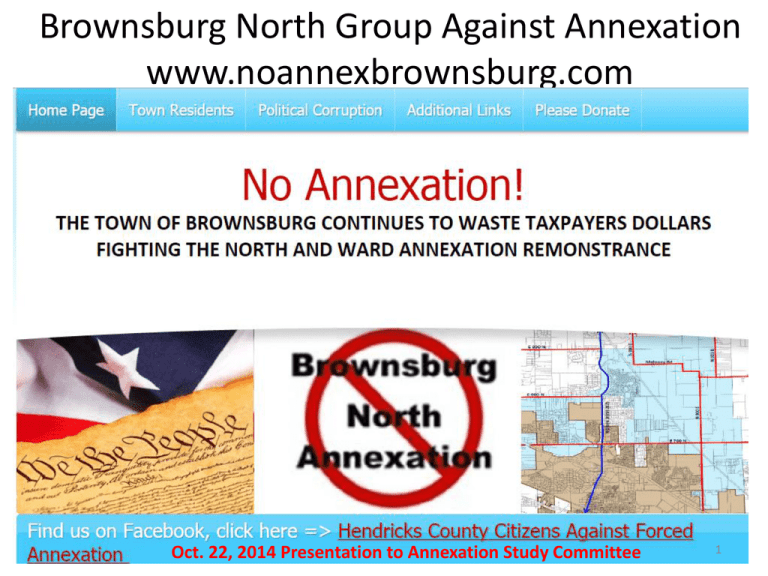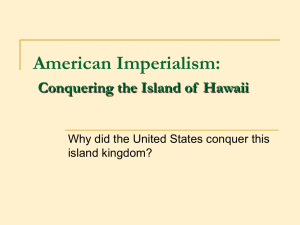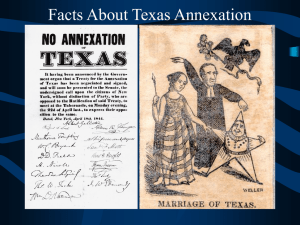The recommended change
advertisement

Brownsburg North Group Against Annexation www.noannexbrownsburg.com Oct. 22, 2014 Presentation to Annexation Study Committee 1 The population in the town of Brownsburg is larger than many cities. • According to Wikipedia the town is 11.16 sq miles; estimated population in 2012---- 22,603 • The size of the Brownsburg North Annexation Area is 4,462 acres which is 6.97 sq miles, includes 1,193 property parcels (with 996 Dwellings), Resident Population of this area is 2,639 (estimated) • 77% of this area is agriculture property • This annexation will increase the size of the town by over 50% 2 We have formed a PAC (political action committee) titled Fight Against Brownsburg Annexation (FABA) to help offset the costs associated with litigation. Please join the cause and donate. Make checks or money orders payable to FABA and mail to FABA P.O. Box 258, Brownsburg, IN 46112 For questions call 317-286-7316 The Internal Revenue Service (IRS) forbids individuals from taking charitable contribution deductions for gifts to PACs, political candidates and political organizations. “contributions to the organization are not deductible for federal income tax purposes as charitable contributions” 3 Congratulations to Fortville annexation remonstrators (they were at the last meeting) They received a favorable ruling from the trial court and the annexation has been stopped; That is until Fortville takes the case to the appellant court for appeal- which will most likely happen. Congratulations to the Whitestown remonstrators on their favorable ruling to stop the annexation (who were also at the last meeting) they already know that Whitestown has filed an appeal with the appellant court. Apologies to the Ward remonstrators (Brownsburg annexation) on Oct 2, 2014 the trial court granted Town’s motion to dismiss. Apologies to the Martinsville remonstrators, Appeal court decision Oct 2, 2014 dismissed appeal because remonstrators did not request a stay of the annexation prior to the appeal and during that time the annexation because final. (In this appeal court decision, Judge Baker, writes a separate opinion to express his concerns regarding the time period during which remonstrators may request a stay. While he agrees that, the appeal court had to dismiss the remonstrators appeal as moot because the annexation had become final. He fears that the clerk of a municipality may be able to finalize an annexation without allowing a reasonable time for remonstrators to request a stay.) 4 Involuntary forced annexations must be stopped Indiana is only one of two states that continues to allow this archaic practice. Tennessee banned forced annexations last year; the year before North Carolina banned this practice because it was determined that involuntary annexation was in violation of the United States Constitution– violating the fourteenth amendment right of equal protection. -----Stating that representation in state and local government is a fundamental right and involuntary annexation violates principles of equal protection since no representation in the annexation process is given to residents of the annexation area . 5 • In 2012 North Carolina banned involuntary annexation (the new annexation process requires a voter referendum of those residing in the annexation area). • Additionally, in 2012 North Carolina passed House bill 5 which deannexed legal, pending and completed annexations in nine involuntary annexations from across the state and imposed a 12-year prohibition on any annexation attempt of these areas. (The nine annexations are from Kinston, Lexington, Rocky Mount, Wilmington, Asheville/Biltmore Lake, Marvin, Southport, Goldsboro, and Fayetteville/Gates Four.) 6 Some changes to the Indiana annexation statute (Indiana Code 36-4-3) has occurred over the years in an attempt to preserve property owner rights. • Unfortunately , these changes have done little to help property owners, in fact the changes have sparked a concern and a fear of potential changes that are likely to occur and has resulted in a surge in involuntary annexations across the state. 7 • Requirements placed on landowners in an area targeted for annexation clearly establishes an unfair playing field and makes it almost impossible for landowners to conduct a successful remonstrance due to: – lack of municipality accountability – difficulty acquiring needed public documents from the municipality; documents request are frequently denied – time limitations for filling written remonstrance – signature requirements needed to file a claim – the legal cost associated with bringing a remonstrance action to court (Municipalities have access to legal resources while property owners do not) 8 How many property owner annexation remonstrance cases have been truly successful in the History of Indiana? 9 I could be wrong, and if anyone knows otherwise Two let me know, but I can only find truly successful property owner remonstrance cases in the History of Indiana. In a recent Indiana Appeal Court memorandum decision not for publication dated August 5,2014( this decision cannot be used a precedent or cited before any court) Remonstrators met all requirements of Indiana code 36-4-3-13 (e) and won. “City of Sullivan v North American Latex Corporation et al” (remonstration Nov 2012- August 5, 2014) June 6, 2002 Indiana Appeal Court found in favor of remonstrators, because parcels included in serial annexations were not contiguous to the town. “Town of Lizton vs. Storm and Shelton” (remonstration May 1998- June 6, 2002) 10 On going remonstrance case • The City of Boonville vs American Cold Storage remonstrance started in July 2008. A January 21, 2014 Supreme Court decision has remanded this case back to the trial court for further proceedings. – This remonstrance has been on going for 6 years – I wonder how much money the remonstrators have spent in legal fees? – But the bigger question is, How many hundreds of thousands of taxpayer dollars have been wasted fighting against this remonstrance? – These taxpayer dollars could have been better utilized updating infrastructure, instead of being thrown away on legal fees. This is one of the many reasons why involuntary forced annexation must be stopped 11 Clarification of information presented at the last meeting • Cities and town representatives at the last meeting indicated that towns and cities can offer exemptions that allows agricultural property to remain exempt from property tax liability for municipal purposes and that this zoning classification cannot be changed without the consent of the owner. • While this may be true, I doubt and I am surprised that after section 4.1 of the statute changed in 2013 that any municipality would use this section of the statute for any involuntary annexation. As a result of the 2013 change— “territory annexed under this section may not be considered a part of the municipality for purposes of annexing additional territory under section 3 or 4 of this chapter.” This means that the municipality cannot use this boundary to meet the 12 contiguity requirement for future involuntary annexations. • The Town of Brownsburg amended our annexation ordinance to clearly state, “The town is not annexing this territory under I.C. 36-4-34.1”. • It never was annexing this territory under Section 4.1, but the town felt the need to add this for clarification.(probably because it had been brought to the attention of the town that the east annexation boundary could not be included in our annexation to determine continuity.) 13 • If involuntary forced annexation is going to be allowed to continue, an addition to sec 4.1 needs to be added • The recommended change: legislative addition to section 4.1----Require that all land zoned or used for agricultural purposes at the time of annexation must be given the agricultural exemption under IC 36-4-3-4.1. Municipality cannot state that annexation territory is not being annexed under section 4.1(recommended change) 14 I agree with many of the things that attorney, Steve Buschmann spoke of at the last meeting. I want to applaud Mr. Buschmann for suggesting changes to the annexation statute, even though these changes are not in his best interest given the fact that annexation remonstrators are a large part of his client base. I am going to talk about some of the things he addressed at the last meeting. • He said that in 1999 the Indiana Code changed that required a court to order an annexation not to take place if certain requirements were met. Before this change, this only applied to an annexation in St. Joseph County. • The intent of the addition to the statute in 1999 was to allow this to apply to all areas involved in annexation and not just St. Joseph County, but due to the wording of the addition---all other annexation areas continued to be excluded. • It was not until the change in 2003 that allowed the court to order an annexation not take place if certain requirements were met. • In 2003 this was removed from (e) “this subsection does not apply to a city located in a county having a population of more than two hundred thousand but less than three hundred thousand.” 15 • The reason I bring this up is because when changes are made to the statute the changes must be reviewed by several individuals to assure that the wording will create the intended result • Example: Steve Buschmann suggested: Require that all land zoned or used for agricultural purposes at the time of annexation qualify for the agricultural exemption under IC 364-3-4.1. (He wrote this so that properties that are not zoned agricultural but are using their property for agricultural purposes would qualify for the agricultural exemption.) • However, the word “qualify "as stated above, will not provide the intended result of allowing all land zoned or used for agricultural purposes to receive the agricultural exemption; because the municipality can (as ours did) say the annexation is not being adopted under the section 4.1. 16 • Mr. Buschman also spoke about statute requirements by municipalities and indicated that the courts do not apply consequences if the municipalities do not follow these requirements. – This is because there is nothing written into the statute that applies any consequences to municipalities for failure to follow requirements and this does not void the annexation even if the annexation is illegal. • If involuntary annexation is going to be allowed to continue, many changes need to be made to the statute so that the courts will understand the actual legislative intent. Forced involuntary annexation must be stopped 17 Unless remonstrators met the 65% signature requirement they cannot void an annexation even if the annexation is illegal and there are no consequences to municipalities for failure to follow statute requirements even if remonstrators met the signature requirement. • A section needs to be added to the statute that reads: if a municipality fails to follow all of the statute requirements that any property owner can challenge the legality of the annexation in court…. And if the court finds that the municipality did not follow ALL requirements in the statute, then the annexation will be declared void. (recommended change) This should also be added: If the court finds that the municipality failed to follow statute requirements the plaintiff will be awarded all attorney fees and cost incurred in relation to the claim. (recommended change) ----If remonstrators fail even one of the statute requirement’s they lose---18 • The statute currently allows an owner of land within ½ mile of territory proposed to be annexed to appeal the annexation only if the territory sought is not contiguous to the municipality. – This does not even allow property owners in the proposed territory to appeal if the area is not contiguous. – And this does not allow for an appeal for any other reason---even if the annexation is illegal • IC 36-4-3-15.5 Appeals after final publication of annexation ordinance; procedure; effective date Sec. 15.5. (a) Except as provided in subsection (b), an owner of land within one-half (1/2) mile of territory proposed to be annexed under this chapter may, not later than sixty (60) days after the publication of the annexation ordinance, appeal that annexation to a circuit court or superior court of a county in which the annexed territory is located. The complaint must state that the reason the annexation should not take place is that the territory sought to be annexed is not contiguous to the annexing municipality. (*subsection (b) refers to voluntary annexation) 19 • Further, cities and towns claim that involuntary annexation is necessary to bring in property that is completely surrounded by a municipality and to square up municipal boundaries. 20 The town included these 3 parcels as pretext to contiguity to connect the west and east areas which would otherwise be 2 separate annexations. Done in an effort to circumvents the legislative contiguity requirement. This does not square the boundary. These areas are excluded from the annexation and will be completely surrounded by the incorporated area This is not squaring the boundary 21 If you look at the previous map • The Town of Brownsburg is creating the very situation that cities and towns claim to be a reason for the continued need for involuntary annexations. (The white areas inside of the blue proposed annexation area are excluded from the annexation and will be completely surrounded by the incorporated area if this annexation is allowed to continue.) • Many property owners in the excluded areas have failing septic systems and had previously petitioned the town wanting water and sewer services and wanted to be annexed. (actually this has been on going since early 2000) These property owners were very upset to find out that their property was excluded from the annexation. 22 • Further, cities and towns claim that involuntary annexation is necessary to bring in property that is completely surrounded by a municipality. 24 Previous map is the Town of Brownsburg. The x’s show 4 of 5 involuntary annexations that were introduced in March 2013.(the other annexation introduced in March was the North annexation territory) Notice all of the territory surrounded by the town that is not being annexed. Size of annexation areas(27 Acres, 68 Properties 60 Dwellings, 159 Resident Population (Estimated), 44 Acres, 1 Property 1 Dwelling, 3 Resident Population (Estimated), 36 Acres, 2 Properties No Dwellings, 0 Resident Population (Estimated), 404 Acres, 131 Properties 86 Dwellings, 228 Resident Population (Estimated) 25 The Indiana Advisory Commission on Intergovernmental Relations (IACIR) municipal annexation survey completed by the Town of Brownsburg indicates that these annexations were done to square municipal boundaries, absorb islands of unincorporated land and various other reasons---Further, Brownsburg claims in the survey that fire protection for all of the annexation areas is provided by the municipality, when in fact our fiscal plan states that fire protection is not provided by the municipality but by the fire territory. (this will not change even if annexed) Most of the other information provided by the town in this survey is also incorrect. This would suggest that the results of this survey will provide a gross misrepresentation of “facts” as it relates to the annexations across the State of Indiana. Maybe the survey that should be done is a survey to determine how many billions of taxpayer dollars has been used (wasted) to pay legal fees fighting against annexation remonstrance and declaratory judgment cases? 26 This area is completely surrounded by the incorporated area and it is not included in theses annexations. Elkhart annexations • • • • • • • • • • • • • • • • • This island is being created by one of the proposed annexations Proposed annexation 1 (Phase 1) Proposed annexation 2 (Phase 1) Proposed annexation 3 (Phase 1) Proposed annexation 4 (Phase 1) Proposed annexation 5 (Phase 2) Proposed annexation 6 (Phase 2) Proposed annexation 7 (Phase 2) Proposed annexation 8 (Phase 2) Proposed annexation 9 (Phase 3) Proposed annexation 10 (Phase 4A) Proposed annexation 11 (Phase 4) Proposed annexation 12 (Phase 3) Proposed annexation 13 (Phase 4) Proposed annexation 14 (Phase 3) Proposed annexation 15 (Phase 3) Proposed annexation 16 (Phase 4) The colored areas indicate the proposed annexations areas, these annexations are definitely not squaring up the municipal 27 boundaries • Elkhart map shows that the City is not annexing the areas completely surrounded by the municipality and the 16 proposed involuntary annexations certainly are not being done to square the municipal boundaries. –IACIR municipal annexation surveys completed by Elkhart did not even include information on any of these 16 proposed involuntary annexations. 28 • I disagree with City and Towns statement--- that most involuntary annexations are not adversarial. If by not adversarial they meant, that a remonstrance was not filed--- then they are correct. • The reason property owners do not remonstrate is because remonstration takes an enormous amount of time, money and effort. (All provided by property owners.) • And as previously stated-- there has only been two truly successful property owners annexation remonstrance in the history of Indiana. • Municipalities use their employees and taxpayer dollars to fund the involuntary forced annexation. 29 Cities and towns representative spoke about selling owners on the annexation With involuntary annexation many towns and cities are trying to sell something that properties owners do not want, do not need and simply cannot afford; but property owners have no say in the matter. The only way to avoid buying what the town is selling is to take them to court. (at the property owners expense) 30 The fiscal plan, according to the statute, must show the following: (5) That services of a capital improvement nature, including street construction, street lighting, sewer facilities, water facilities, and storm water drainage facilities, will be provided to the annexed territory within three (3) years after the effective date of the annexation in the same manner as those services are provided to areas within the corporate boundaries, regardless of similar topography, patterns of land use, and population density, and in a manner consistent with federal, state, and local laws, procedures, and planning criteria. 31 • By “will be provided” did the legislative intend that the services were to be provided at the municipality expense or was the legislative intent that the services be provided largely, if not wholly, at the expense of the property owner -----as stated in our fiscal plan (Brownsburg North fiscal plan) • So either: – the services will not be extended unless property owners pay – or the services will be extended and the property owners will be forced to pay. Obviously it the later of the two, because the statute says “Capital services…. will be provided… within three years after the effective date of the annexation.” 32 How would you feel if I made you buy something that you did not want? • Too bad you have to buy it anyway – It does not matter if you cannot afford it • Municipalities' do not care if property owners are forced into bankruptcy or foreclosures on their property because of the associated cost of annexation (increased taxes, availability fees, water and sewer hook up fees, monthly water and sewer fees, etc.) 33 *More about Elkhart annexation • Property owners from Area 8 filed a remonstrance against the annexation. • Area 8 has 24 parcels(the city claims 33 parcels) • The City claims the area is needed and can be used but does not indicate what the area is needed and can be used for. • 19 parcel owners signed opposing the annexation which is 79 % of the landowners (65% is required) (There are actually only 12 different property owners because some of the owners have more than one parcel) 34 35 • *Of these 12 owners opposing this annexation --most of these owners are retired and are on fixed incomes. • The city plan indicates that all property owners will have to connect to city water and sewer services (they will have a abandon there septic system as by statue, but will be allowed to use their well for lawn watering, washing cars, filling pools etc, but the well must be disconnected from the house plumbing) • The property owners will be responsible for paying availability fees, tap fees, and connection fee for these city services; this is not an option, it is a requirement. The property owners that cannot afford this will likely lose their property. • They have filed a written remonstrance but due to their limited financial resources they were unable to afford an attorney to represent them. • They filed together and each property owner will be representing themselves as required by law. Note: I recently looked at the City of Elkhart web site to obtain the actual cost indicated for water and sewer connection and I can no longer find this 36 information; so it has either been moved or changed. *They meet all of the requirements in the annexation statue to successfully stop this annexation• the Remonstrators are adequately furnished with police, fire protection, and street and road maintenance (see IC 36-4-313(e)(2)(A)) • the annexation will have a significant financial impact on the owners of land (see IC 36-4-3-13(e)(2)(B)) • Annexation is not in the best interests of the owners of land in the territory proposed to be annexed (see IC 36-4-313(e)(2)(C)) • Remonstrators have attached hereto the signed remonstrance petitions of more than “sixty-five percent (65%) of the owners of land in the annexation territory” (see IC 36-4-313(e)(2)(D)(i)). Fiscal plan for this area indicates that police, fire protection, street and road maintenance services are furnished by a provider other than the municipality. 37 *After filing their written remonstrance the City’s representing attorney responded claiming: • The petition is barred because it fails to state a claim upon which relief can be granted. • The petition is barred by the doctrines of laches and unclean hands. • The petition is barred because petitioners lack standing to assert their claims. The city request that the Court enter judgment in its favor and against the petitioners. 38 *What are these remonstrators to do? • They cannot not afford an attorney and they are unsure of how to proceed. • Remonstrators are likely to lose this fight simply because they cannot afford to fight….. They not only will lose this fight…. Many will lose their property because they will be unable to pay for what the City has forced them to buy!!!! Involuntary annexation must be stopped 39 *More Elkhart Annexation • Area 6 is 265 parcels– the city claims it is 60% subdivided – When in fact it is not subdivided, which is required by the annexation statute • The City did not include contiguous area of I-80 (toll road) in the annexation territory even though the Indiana code clearly indicates that it must be included IC 36-4-3-2.5 "Public highway" defined Sec. 2.5. (a) As used in this section, "public highway" has the meaning set forth in IC 9-25-2-4. (b) An annexation of territory under this chapter after June 30, 1996, that includes land contiguous to a public highway must also include contiguous areas of: (1) the public highway; and (2) rights-of-way of the public highway. As added by P.L.232-1996, SEC.1. 40 41 *If the Toll road would have been included as required by statute the city would have also had to notify adjacent property owners--- which the city did not do • IC 36-4-3-2.2 Notice by certified mail (c) For purposes of an annexation of territory described in section 2.5 of this chapter, if the hearing required under section 2.1 of this chapter is conducted after June 30, 2010, the notice required by this section must also be sent to each owner of real property, as shown on the county auditor's current tax list, whose real property is adjacent to contiguous areas of rights-ofway of the public highway that are only included in the annexation of territory by operation of IC 36-4-3-2.5 on the side of the public highway that is not part of the annexed territory. 42 *This is just another example of a municipality not following the statute requirements but the property owners cannot do anything about it. • These property owners also have limited resources---the remonstrators just got their first bill from the attorney for $4,000; and that was just to file the written remonstrance. • These remonstrators will likely lose their remonstrance if they cannot afford to be represented in court by an attorney; and a remonstrator cannot represent the group because that would be practicing law without a license. • If a remonstrator wanted to represent themselves they would lack standing, because in order to have standing 65% of the owners must oppose the annexation. (now we are back to practicing law without a license) Involuntary forced annexations must be stopped 43 Here is the Indiana Code that applies remonstrance filing and determination of signatures --Our group felt this section of the statute was clear ---- apparently it was not as clear as we thought….. 44 IC 36-4-3-11 Remonstrances; filing; determination of signatures; hearing • Sec. 11. (a) Except as provided in section 5.1(i) of this chapter and subsections (d) and (e), whenever territory is annexed by a municipality under this chapter, the annexation may be appealed by filing with the circuit or superior court of a county in which the annexed territory is located a written remonstrance signed by: (1) at least sixty-five percent (65%) of the owners of land in the annexed territory; or (2) the owners of more than seventy-five percent (75%) in assessed valuation of the land in the annexed territory. The remonstrance must be filed within ninety (90) days after the publication of the annexation ordinance under section 7 of this chapter, must be accompanied by a copy of that ordinance, and must state the reason why the annexation should not take place. 45 The Indiana Code indicates how to determine the total number of landowners. • (b) On receipt of the remonstrance, the court shall determine whether the remonstrance has the necessary signatures. In determining the total number of landowners of the annexed territory and whether signers of the remonstrance are landowners, the names appearing on the tax duplicate for that territory constitute prima facie evidence of ownership. 47 The Indiana code goes on to say • Only one (1) person having an interest in each single property, as evidenced by the tax duplicate, is considered a landowner for purposes of this section. • IC 36-4-3-13 Remonstrances; hearing; order; requirements (e) ……(D) One (1) of the following opposes the annexation: (i) At least sixty-five percent (65%) of the owners of land in the territory proposed to be annexed. (ii) The owners of more than seventy-five percent (75%) in assessed valuation of the land in the territory proposed to be annexed. Evidence of opposition may be expressed by any owner of land in the territory proposed to be annexed. 51 Now our annexation: We filed a remonstrance with over 65% of parcel owners signatures. Actually we submitted signatures of 70.66% (843 parcel owners out of 1193 total parcels) (Subtract a few waivers, not current owner because property transfer took place after owner had signed, we ended up with a total of 829 parcels signatures ) total now is 69.48% which is still well above the 65% requirement. 54 The town filed a motion to dismiss claiming we did not meet the 65% requirement for two reasons: 1. Town claims that signatures of a landowner had to be signed after the ordinance was passed and published. (all of our signed parcels signatures came after the ordinance was introduced and after property owners had received the certified notice in the mail) 2. Town claims that if a parcel is multi-owned that all landowners signatures have to be signed for that parcel for that parcel to be counted for the purposes of the 65% rule. 55 IC 36-4-3-11 Remonstrances; filing; determination of signatures; hearing Sec. 11. (a) Except as provided in section 5.1(i) of this chapter and subsections (d) and (e), whenever territory is annexed by a municipality under this chapter, the annexation may be appealed by filing with the circuit or superior court of a county in which the annexed territory is located a written remonstrance signed by: (1) at least sixty-five percent (65%) of the owners of land in the annexed territory; or (2) the owners of more than seventy-five percent (75%) in assessed valuation of the land in the annexed territory. The remonstrance must be filed within ninety (90) days after the publication of the annexation ordinance under section 7 of this chapter, must be accompanied by a copy of that ordinance, and must state the reason why the annexation should not take place. (b) On receipt of the remonstrance, the court shall determine whether the remonstrance has the necessary signatures. In determining the total number of landowners of the annexed territory and whether signers of the remonstrance are landowners, the names appearing on the tax duplicate for that territory constitute prima facie evidence of ownership. Only one (1) person having an interest in each single property, as evidenced by the tax duplicate, is considered a landowner for purposes of this section. 56 Trial court found we did not meet the 65% requirement because of the date of some parcel signatures. The town attorneys’ misrepresented the “City of Carmel v Certain Southwest Clay Township Annexation Territory Landowners”, 868 N.E.2d 793, 800 (Ind.2007) Supreme court ruling. ; the Judge obviously failed to read the ruling and the Judge, in error, relied on town's interpretation. (The Indiana statute does not state nor imply that signatures have to be dated after the ordinance is passed; and no one signed opposing the annexation ordinance until after it was introduced.) We have filed an appeal with the appellant court. 57 Now the town once again is going to use both arguments as to why we do not meet the 65% requirement. This will cost the property owners even more money. From the start, the Town of Brownsburg has filed many frivolous motions in an effort to run us out of money. Unlike the town, our resources are limited. The town is using and wasting taxpayers dollars fighting this annexation remonstrance; they do not care, after all it is not coming out of their pockets. 58 Clarifications need to be added to the filing and determination of signature section of the annexation statute. IC 36-4-3-11 Remonstrances; filing; determination of signatures; hearing The remonstrance must be filed within ninety (90) days after the publication of the annexation ordinance under section 7 of this chapter, must be accompanied by a copy of that ordinance, and must state the reason why the annexation should not take place. (clarification should read)Parcels owner signatures opposing the annexation can be obtained any time after the introduction of the annexation ordinance. (recommended change) (There has never been a court decision as to this issue, probably because before the Town of Brownsburg used this argument—it was understood that signatures could be obtained anytime after the introduction of the ordinance since the statute does not state otherwise; and the town simply used this argument in a desperate attempt to invalidate our signatures;--- our group had been informed that the town said we would never be able to get the 65% required to file a written remonstrance) 59 The other clarification to this section: • (b) On receipt of the remonstrance, the court shall determine whether the remonstrance has the necessary signatures. In determining the total number of landowners of the annexed territory and whether signers of the remonstrance are landowners, the names appearing on the tax duplicate for that territory constitute prima facie evidence of ownership. (clarification should read) Only one parcel owner signature is required for parcel to count toward the % required to remonstrate. (recommended change) (Supreme court decision March 29, 2000 “Arnold v City of Terre Haute” already supports this addition; the clarification will help to prevent City's and Towns from filling frivolous motions claiming otherwise— which is done in an effort to deplete remonstrators financial resources.) 60 • One of the farmers (that owns multiple parcels) in our annexation area told me that he was against annexation but would not sign the petition to remonstrate the annexation because he had been told that if he did not fight the annexation that the town would allow him to continue to farm. He was afraid that if he signed a petition against the annexation and we lost that the town would make sure to change zoning to prohibit farming of his property. 61 • The town also had told him that even if we got the required of signatures that the annexation cannot be stopped because the town has met the requirements in the statute. • I was told the same thing by one of the council members. Apparently the town attorneys failed to realize that the annexation statute had changed in 2003. ( it was implied that we did not have enough money to fight the town) 62 *Town of Brownsburg Ward annexation (404 Acres, 131 Properties 86 Dwellings, 228 Resident Population) remonstrance got dismissed even though the town failed to meet the requirements in the annexation statute. (IC 36-4-3-3.1Written fiscal plan states: the municipality shall establish and adopt the written fiscal plan before mailing the notification to landowners in the territory proposed to be annexed) – the town completely changed the fiscal plan after the notifications had been sent to property owners. – Actually the fiscal plan was not changed, it was an entirely new fiscal plan, the fiscal plan still did not meet the requirement in section 13(d) and this fiscal plan was adopted the same night the annexation ordinance was passed on third and final reading. – And the town provided no reason as to why they claimed the area was needed and can be used. 63 • *The remonstrators lost because they did not meet the 65% signature requirement. (Their attorney failed to file signatures of all property owners that had signed opposing the annexation because he was worried about the wording of the signed documents) The number fell just below the percentage required. • And remonstrators lacked standing to bring a declaratory judgment claim against the town because they were not tax payers of the town. An amended complaint was filed on behalf of town tax payers, but the court still ruled on behalf of the town and dismissed the case. • Remonstrators cannot afford to file an appeal. Forced involuntary annexations must be stopped 64 • Cities and towns are abusing the annexation process simply to increase municipality revenue without regard to the effects on the people and the other taxing bodies. • In our situation, had the annexation went into effect in Feb 2013 as planned, the Brownsburg School corporation would have lost over $400,000 in revenue in 2015 and that yearly loss of revenue would most likely increase each year if this territory is annexed. The fire territory would have lost approx. $80,000 in revenue yearly, the public library loss of revenue would have been approx. $23,000 yearly, and Brown township loss of revenue would have been approx. $12,000 yearly. (See provided letter to parents from the Brownsubrg School corporation) 65 • Filing a remonstrance to annexation requires a tremendous (huge, vast, enormous, massive, gigantic, immense, colossal) amount of time, effort and money; – Large annexations make it difficult to get the required signatures --it takes a huge amount of time to contact all property owners needed to meet the 65% requirement. 66 • Small areas annexation are difficult because remonstrators do not have the financial resources necessary to file a written remonstrance (not to mention that one of the criteria to win an annexation remonstrance is that remonstrators must show it will have a significant financial impact on them.) • If involuntary forced annexation is going to be allowed to continue then the requirement that remonstrators' must show that the annexation will have a significant financial impact should be removed from the statute. (IC 36-4-3-13(e)(B)) (recommended change) Cities and towns are aware of both of these hurdles and use these situations to their advantage. 67 • Financial resources are hard to come by. – The majority of people know this is a fight that few win. • *Contacting owners can be difficult---Brownsburg certified letter notification was dated March 07, 2013 and the list of property owners used by the town had not been updated since March of 2012. According to the statute-(IC 36-4-3-2.2 Notice by certified mail) (b) …. notice must be sent by certified mail… to each owner of real property, as shown on the county auditor's current tax list. Between March 16, 2012 and February 28, 2013, there were 30 property transfers (2.5 percent of the 1193 parcels that were being annexed). In addition, 75 of Brownsburg’s certified mailings to parcel owners were returned as undeliverable (6.3 percent of the 1193 parcels). (statute goes on to read---(e) If the municipality complies with this section, the notice is not invalidated if the owner does not receive the notice.) 68 • *As a result, 100 parcel owners were not properly notified(as required by statute) and were denied their rights to adequate notice of and information about the proposed annexation. • Further, in seeking petitions of remonstrance, Remonstrators spent significant time and resources understanding this error and identifying the correct parcel owners. • Although 8.4 percent may seem like an insignificant number, the failure to notify these parcel owners was significant to each of them. Further, 8.4 percent is a significant portion of the 65 percent of the parcels required to remonstrate under IC 36-4-3-11(a)(1). 69 • *There is no penalty to the town for using an out dated property owner list and no penalty that 75 property owners did not get their certified letter. • *We submitted our written remonstrance and found out that 10 of the parcels had changed ownership and therefore that was 10 less signed parcels that we had…… There is nothing in the statute that allows us a chance to get the new owner to sign opposing the annexation. (of these new owners, I have spoken with most of them and they too oppose the annexation, but they are not allowed to sign and have their signature count toward the required 65 percent.) 70 There needs to be an addition to the statute that requires the municipality to provide a list identifing each parcel in the annexation area. IC 36-4-3-2.2 Notice by certified mail • (d) The notice required by this section must include the following: (7) A statement that the municipality will provide a copy of the fiscal plan after the fiscal plan is adopted immediately to any landowner in the annexed territory who requests a copy. a statement that the municipality will provide a copy of the list identifying each parcel to be annexed immediately to any landowner in the annexed territory who request a copy. This list will include each parcel number, owner name, property address, and owner contact address. (also to be made available in spreadsheet format) (recommended change) 71 There needs to be an addition to IC 36-4-3-11 • Signatures requirements---- after parcel signatures have been submitted to the court with written remonstrance and it is found that any of the signatures are no longer valid because the person is not the current owner of the property, the municipality must provide the remonstrators a list of the new property owners and after this notification is received remonstrators have an additional 90 days to contact new property owners to determine if they are for or against annexation. (recommended change) • If the municipality fails to notify remonstrators of property owner changes, then the submitted parcel owner signatures are valid even if the property has changed ownership. (recommended change) 72 Most of the previous recommended changes will be unnecessary if Involuntary Annexation is prohibited • Require all municipal annexations to have 51% of parcels approval at the outset; this would be an addition to the statute and would require multiple changes in the annexation chapter---sections of the statue to be repealed. (recommended change) 73 There are so many changes that need to be made to the annexation chapter if involuntary forced annexations are allowed to continue. If legislature does not ban involuntary forced annexation • Provide that in an involuntary annexation fails, if 51% of the parcels or 51% of the assessed value files remonstrance petitions within 180 days after publication.(currently it is 90 days after publication) Upon certification of the validity of the remonstrance, the municipality cannot involuntarily annex any part of the territory for 4 years.( this also prohibits any other municipality from involuntarily annexing any area of this territory during the 4 year period.) Removing the remonstrance hearing process all together. (recommended change) • Recommend that this statute change take effect upon passage and applies to all annexations not yet in effect and/or in litigation. (recommended changes) • The above changes need to be added even if involuntary 74 annexations are banned • IC 36-4-3-1.5 Contiguous territory; determination Sec. 1.5. For purposes of this chapter, territory sought to be annexed may be considered "contiguous" only if at least oneeighth (1/8) of the aggregate external boundaries of the territory coincides with the boundaries of the annexing municipality. In determining if a territory is contiguous, a strip of land less than one hundred fifty (150) feet wide which connects the annexing municipality to the territory is not considered a part of the boundaries of either the municipality or the territory. Proposed involuntary annexation territory cannot exclude areas from the annexation by going around the area, all areas have to be included. Boundary lines must be squared or straight. (recommended change) This change will prevent towns and city's from “Cherry Picking” areas that will bring in increased revenue and excluding areas with problems or low revenues; as has been done with our 75 annexation area *Addition to remonstrance hearing process • Recommended addition to section 13--The municipality cannot request discovery, production of documents and/or admissions from remonstrators. (municipalities simply use this tactic to further deplete remonstrators financial resources; what documents would remonstrators have that would be of any value to the municipality.) (recommended change) • This change probably cannot be added, but something needs to be added to protect remonstrators financial resources. (discovery requested by the town from the North remonstrators--- include 33 interrogatories, 6 request for documents, 4 request for admissions) 76 *IC 36-4-3-15 Remonstrances; judgment; repeal of annexation; effective date of annexation • Addition to (c) (d) and (e)time periods regarding further attempts to annex territory following a municipality repeal of an annexation ordinance applies to all annexation ordinances in which a claim of appeal has been filed with the court. (recommended changes) Remonstrators involved in the case of “Town of Georgetown v Edwards Community INC” , Indiana appeal decision May 8, 2008 was denied the forty-two month moratorium on future annexation attempts by the Town because remonstrance was facially insufficient under Section 11. 77 • Do what North Carolina did and pass a bill that will deannex legal, pending and completed annexations in which the municipalities failed to follow all statute requirements or tried to circumvent annexation statute requirements. (recommend change) 78 Recommend that clarifications added to sections of the annexation statue are retroactive. Specifically, signature requirements for filing and determining the % of landowners. (recommended change) Previous clarification recommendations : Parcels owner signatures opposing the annexation can be obtained any time after the introduction of the annexation ordinance. Only one parcel owner signature is required for parcel to count toward the % required to remonstrate. 79 • The Town of Brownsburg has budgeted $450,000 in legal fees for 2015 … this amount is budgeted due to anticipated legal fees associated to the remonstrance to annexation. • Legal fees budgeted for 2014 was $425,000 due to the anticipated legal fees associated with annexations; we do not know how much the town has spent so far in legal fees, we do know that they have paid $90,000 in legal fees related to request for public documents ----to me that seems a little excessive---Why do so many of our public documents request go through the town attorneys’? One may think that the town is trying to hide something. This type of action by the town makes me question governmental transparency. Public documents are supposed to be just that---PUBLIC. 80 Involuntary forced annexations must be stopped This is the end of the presentation, but not the end of the fight. Brownsburg North Group Against Annexation 81 Please Put a Stop to Involuntary Forced Annexations Thank you • Recommended changes are on the following slides 14, 18, 59, 60, 67, 71-79 82 • • • • Brownsburg North Group Against Annexation. $18,053.80 is the total expenses paid out of our FABA PAC to date. $16,019 to date for attorney fees --Keep in mind most of the brief writing has been done by myself and another individual in our group. Briefs are sent to our attorney for review, any necessary changes made and then filed; saving over $40,000 in legal fees. (Our court CCS (chorological case summary) is 5 pages long—town has filed many frivolous motions in an effort to deplete our financial resources.) $450 paid to courts for filing fees-- $200 trial court and $250 to appeal court. (Of interesting note--- municipalities do not have to pay filing fees even if it is the municipality that files the appeal.) $1,584.80 for copying supplies, P.O. Box fees, and other miscellaneous fees. • Before PAC was formed– approx. $4,000.00 or more was spent for postage, web site design and maintenance, advertising cost including--- news paper ad, yard signs, t-shirts, public documents request coping fees, etc. • This does not include the thousands upon thousands of hours spent by many gathering information, learning and understanding annexation law, reviewing past annexation remonstrance cases, collecting signatures, stuffing envelopes, tracking signed petitions, organizing materials, tracking donations and filing required periodic PAC information forms, finding an attorney, writing briefs, etc. 83









